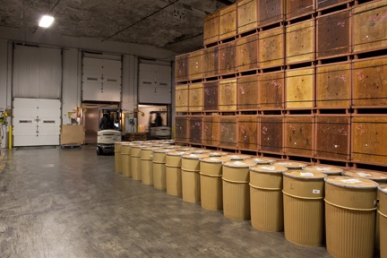The Area Development Frontline series offers insight into successful, innovative strategies taken by businesses; intelligence on locations that are deploying winning policies that attract investment and talent; and reports on industry trends that affect and shape the global business climate now and in the future.
Two years ago, Kraft Foods nearly doubled the size of a refrigerated warehouse it operates in Springfield, Missouri. But visitors to the site would likely have a tough time finding it: The 400,000-square-foot facility is located 100 feet below street level in an underground limestone mine called Springfield Underground.
Kraft has maintained the site since the 1960s, when below-surface storage was relatively novel. (Now, everyone from WikiLeaks founder Julian Assange to data center operators are looking beneath the earth for storage). Today, sustainability and reduced energy costs lead the list of benefits Kraft has discovered in its underground location.
Springfield Underground
Springfield Underground began operating around 1960, attracting businesses seeking to cut warehouse costs. Kraft's facility is the largest addition the complex has undertaken to date; the entire mine is now built out to 2.2 million square feet.
Besides offering cost benefits compared to aboveground storage centers, Springfield Underground President and CEO Louis Griesemer says its central location has also attracted companies.
"You've got a nice, wide-open space in an underground that's close to major highways and infrastructure," Griesemer says. "It seems obvious that you'd try to find a way to utilize that space."
Building the facilities also benefits from the underground location. Springfield Underground works with local, specialized contractors. Building can be completed any time of year because of the constant weather conditions, and the unchanging temperature and humidity offers an ideal environment for curing concrete. Ceiling heights range from 25-45 feet, accommodating cranes, booms, and manlifts. And special anchors hold lights and fixtures from the natural rock ceiling.
The facility reached 1 million square feet of built-out capacity within 15 years, and quickly doubled that square footage and began attracting diversified customers. Besides Kraft, data center Springnet, paper document storage company Edco, and a maker of dry protein drink mixes are all located in Springfield.
Kraft Benefits
Kraft's warehouse is chilled to 36 degrees Fahrenheit to store products such as cheeses, Oscar Mayer meats, and Jell-O puddings. But since the natural temperature below ground is 58 degrees, refrigeration costs are lower than they would be in a traditional, aboveground facility.
"We estimate that we annually use about 65 percent less electricity than in a comparable surface warehouse," says Kraft Foods Springfield Materials Manager Tony Snyder.
And while Forbes named Springfield the U.S. city with the most varied weather in the 2007 article "America's Wildest Weather Cities," the climate underground remains constant, eliminating peak energy costs.
Since there is no landscaping, Kraft doesn't use water for irrigation. And the land aboveground remains undisturbed. "They talk about green roofs," Griesemer says. "Our roof doesn't get any greener because the roof is the pasture."
The location fits into Kraft's corporate sustainability goals. "As a company, we focus on those areas of sustainability where we can have the greatest impact and that means the most to our business performance. So this facility was designed with energy efficiency and sustainability in mind," Snyder says, adding that maintaining the temperature requires only a third of the energy of a comparable aboveground warehouse.
Snyder anticipates a continued Kraft presence at the site. "We designed [the warehouse] with our current and future needs in mind," he says. "That said, there is space for expansion if needed."



